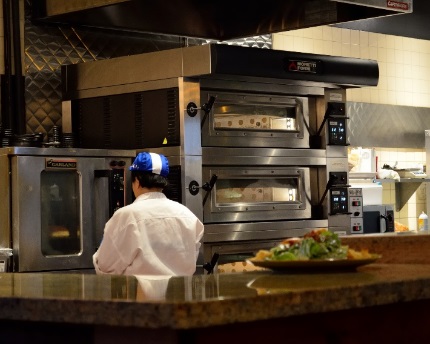Proper ventilation of an occupied space is important for the health and safety of patrons and employees. Kitchen exhaust hoods are important for removing heat, smoke, odors, and particulates from the cooking area to prevent them from exiting the kitchen and infiltrating other areas of the building. Kitchen ventilation in restaurants, office buildings, schools, hotels, hospitals, and other commercial buildings can account for up to 29% of a kitchen’s energy bill. Kitchen exhaust hood controls can significantly reduce the amount of energy consumed while continuing to maintain proper building code ventilation requirements. The following will review the functionality and benefits of exhaust hood controls in commercial kitchens.
Kitchen Exhaust Hood Controls
Typical kitchen exhaust hood controls include demand controlled ventilation and variable frequency drives.
Demand Controlled Ventilation
Kitchen exhaust hoods will exchange the air 15-20 times per hour, on average, to cleanse the environment of smoke, dust, and other potentially harmful air particulate matter. Approximately one-fourth of the energy consumed by the exhaust hoods occur during these air exchange phases. Demand controlled ventilation (DCV) systems adjust the amount of fresh air brought indoors based on the occupancy of a room or space. DCV deploys CO2 sensors in return air ducts to measure CO2 levels against predetermined setpoints. When CO2 levels rise above the prescribed setpoint, controls are triggered, opening air dampers or commanding fans to bring in and circulate additional fresh air until CO2 levels are reduced sufficiently. Without DCV, most kitchens are ventilated with constant airflow, regardless of the kitchen’s occupancy or activity. A DCV system can help reduce wasted energy between 30-50%.
Variable Frequency Drives
Variable frequency drives (VFDs) are controls that detect the temperature, smoke, and/or air quality in commercial kitchens using sensors installed within the exhaust hood and the makeup air unit. VFDs will automatically adjust the speed of the fan motors as appropriate. VFDs can cut exhaust hood energy consumption between 20-50%. Other benefits of a VFD include:
- Reduced fan noise
- Reduced electric demand (kW)
- Power factor correction
- Soft start
- Reduced maintenance costs
Reduced Maintenance Costs
Kitchen exhaust hood controls reduce maintenance costs in a few different ways:
- Slows down the motors to reduce wear and tear
- Reduces the amount of makeup air required to be brought into the space and conditioned
- Lessens the strain on the heating and cooling system
- Reduces the frequency with which the system must be cleaned
Bottom Line
Installing kitchen exhaust hood controls is a smart investment, with a simple payback, on average, of less than two years. Plus, many utility energy efficiency programs offer incentives to offset the upfront capital cost, and some offer on-bill financing. Simply put, installing exhaust hood controls enhances operations, reduces energy and maintenance costs, and improves the lifespan of the equipment.




